

Brand Values and Marketing for Startups, Product Cadence, Premature Scaling & No-shot Startups. Making Product Hunt — on startups. People seemed to like it but the email list was limiting.
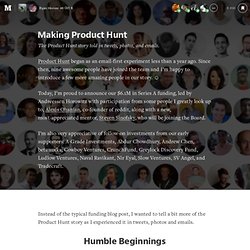
I wanted to build a site where I could chat about products with fellow enthusiasts. So, I asked my buddy Nathan for guidance. While Nathan was at his parents’ house over Thanksgiving break, we hopped on Skype and bounced around ideas, sharing sketches of what Product Hunt might look like. Here’s an early wireframe he created: But before building the site, we reached out to friends and early users of the email list, asking for feedback. We printed “Glasshole Kitty” t-shirts, designed by Product Hunt fan, Jesse Thomas. We surprised a few people with stickers in the mail.
We invited some of our closest supporters to private brunches. We hosted larger public meetups. And then people in the community started to do the same, hosting meetups across the globe from Hong Kong to Toronto. “Your Site Has a Cadence:” The Best Blog Post from 2012 You Never Read. The Valuable Startup Equity That's Not Captured in Your Cap Table. I met a founder a few days ago who captured the idea of building brand equity really well.
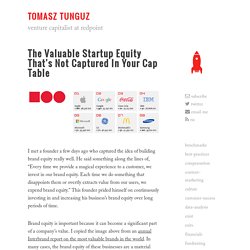
He said something along the lines of, “Every time we provide a magical experience to a customer, we invest in our brand equity. Each time we do something that disappoints them or overtly extracts value from our users, we expend brand equity.” This founder prided himself on continuously investing in and increasing his business’s brand equity over long periods of time. Brand equity is important because it can become a significant part of a company’s value. I copied the image above from an annual Interbrand report on the most valuable brands in the world.
But brand equity isn’t a topic of many conversations in Startupland because unlike revenue, gross margin, cost of customer acquisition or lead velocity, for startups, immediate changes in brand equity are nearly impossible to quantify. Dollar Shave Club and the Modern BrandsDisruption. Dollar Shave Club just celebrated its second birthday.
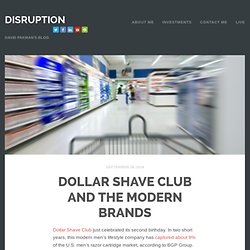
In two short years, this modern men’s lifestyle company has captured about 9% of the U.S. men’s razor cartridge market, according to BGP Group. (This is a measure of market share by units.) It’s a remarkable feat for a young company in a very short amount of time and it shows how dramatically industries can be transformed by new entrants who reimagine a market an entirely different way than how incumbents think. In the case of consumer packaged goods, most are manufactured by CPG behemoths who rely chiefly on two aging mechanisms for building consumer awareness: broadcast marketing and physical retail shelf-space. Dollar Shave Club, and similar modern lifestyle brands like Warby Parker and Bonobos, view these dependencies as a disadvantage and have turned the model on its head. Social marketing done correctly requires far less marketing spend in aggregate than broadcast marketing. Values. Most companies have a mission statement and many have a values statement.
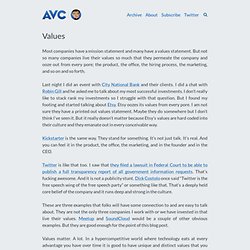
But not so many companies live their values so much that they permeate the company and ooze out from every pore; the product, the office, the hiring process, the marketing, and so on and so forth. Last night I did an event with City National Bank and their clients. I did a chat with Robin Gill and he asked me to talk about my most successful investments. I don’t really like to stack rank my investments so I struggle with that question. But I found my footing and started talking about Etsy. Kickstarter is the same way. Twitter is like that too. A Deeper Look At Blackbox’s Data On Startup Failure And Its Top Cause: Premature Scaling [Infographic] Earlier this week, we covered Blackbox, the young company responsible for creating The Startup Genome Report, an ongoing, collaborative R&D project designed to take a comprehensive dive into what makes Silicon Valley startups successful — and not.
![A Deeper Look At Blackbox’s Data On Startup Failure And Its Top Cause: Premature Scaling [Infographic]](http://cdn.pearltrees.com/s/pic/th/infographic-techcrunch-15289133)
(Read our initial coverage here.) On Tuesday, we covered the company’s launch of what it calls the Startup Genome Compass, a benchmarking tool for startups that helps founders monitor their progress in different growth categories. Since then, more than 6,000 startups have signed up to use the Compass. Along with the diagnostic tool, Blackbox also released a new research report on the major causes of startup failure, including perhaps more significantly, the primary cause of startups kicking the bucket: Premature scaling. Marketing. You asked for it Arnold and 84 others (so far).
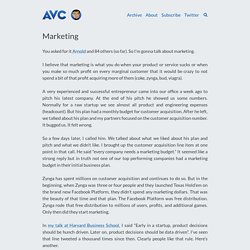
So I'm gonna talk about marketing. I believe that marketing is what you do when your product or service sucks or when you make so much profit on every marginal customer that it would be crazy to not spend a bit of that profit acquiring more of them (coke, zynga, bud, viagra). A very experienced and successful entrepreneur came into our office a week ago to pitch his latest company. At the end of his pitch he showed us some numbers. Hopelessly perfect: Why it's smart to work at a no-shot startup. Think about the promise of the Valley.
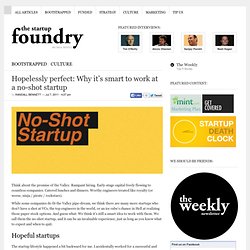
Rampant hiring. Early-stage capital freely flowing to countless companies.